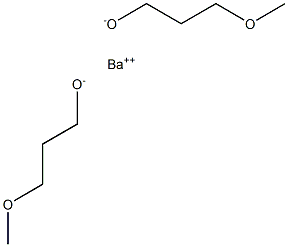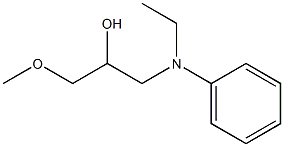1-Methoxy-2-propanol
Synonym(s):1-Methoxy-2-propanol;Propylene glycol methyl ether;Propylene glycol monomethyl ether;Propyleneglycol monomethyl ether
- CAS NO.:107-98-2
- Empirical Formula: C4H10O2
- Molecular Weight: 90.12
- MDL number: MFCD00004537
- EINECS: 203-539-1
- SAFETY DATA SHEET (SDS)
- Update Date: 2025-12-26 12:07:08

What is 1-Methoxy-2-propanol?
Chemical properties
Propylene glycol monomethyl ether is a colorless liquid with a sweet ether-like odor and bitter taste. It is soluble in water, ether, acetone, and benzene.
The Uses of 1-Methoxy-2-propanol
1-Methoxy-2-propanol is primarily used in the manufacture of lacquers and paints, as an anti-freeze in industrial engines, a tailing agent for inks used on very high-speed presses, a coupling agent for resins and dyes in waterbased inks, and a solvent for celluloses, acrylics, dyes, inks, and stains. It is also used in cleaning products such as glass and rug cleaners, carbon and grease removers, and paint and varnish removers; and in pesticide formulations as a solvent for applications to crops and animals.
The Uses of 1-Methoxy-2-propanol
1-Methoxy-2-propanol is used as a solvent for cellulose, acrylics, dyes, inks, and cellophane.
The Uses of 1-Methoxy-2-propanol
1-Methoxy-2-propanol acts as a good biological indicator.
General Description
A colorless liquid. Flash point near 89°F. Less dense than water. Contact irritates skin, eyes and mucous membranes. Prolonged exposure to vapors may cause coughing, shortness of breath, dizziness and intoxication. Vapors heavier than air. Used as a solvent and as an antifreeze agent.
Air & Water Reactions
Highly flammable. Soluble in water. Oxidizes readily in air to form unstable peroxides that may explode spontaneously [Bretherick 1979 p.151-154, 164].
Reactivity Profile
1-Methoxy-2-propanol is a methoxy alcohol derivative. The ether being relatively unreactive. Flammable and/or toxic gases are generated by the combination of alcohols with alkali metals, nitrides, and strong reducing agents. They react with oxoacids and carboxylic acids to form esters plus water. Oxidizing agents convert them to aldehydes or ketones. Alcohols exhibit both weak acid and weak base behavior. They may initiate the polymerization of isocyanates and epoxides.
Hazard
Flammable, moderate fire risk. TLV: 100 ppm; STEL 150 ppm.
Health Hazard
VAPOR: Irritating to eyes, nose, and throat. LIQUID: Irritating to skin and eyes.
Health Hazard
1-Methoxy-2-propanol is a mild toxicant. The toxicity is lower than that of the methyl, ethyl, and butyl ethers of ethylene glycol. The toxic symptoms from inhaling high concentrations are nausea, vomiting, and general anesthetic effects. In humans, toxic effects may be felt at exposure to a level of 3000–4000 ppm.The oral and dermal toxicities in test animals were low. The effects were mild depression of the central nervous system and a slight change in liver and kidney. The recovery was rapid. Irritant actions on the skin and eyes of rabbits were low
LC50 value (rats): 7000 ppm /6 h
LD50 value (rats): 5660 mg/kg.
Flammability and Explosibility
Flammable
Safety Profile
Moderately toxic by intravenous route. Mildly toxic by ingestion, inhalation, and skin contact. Human systemic effects by inhalation: general anesthesia, nausea. A skin and eye irritant. An experimental teratogen. Many glycol ethers have dangerous human reproductive effects. Very dangerous fire hazard when exposed to heat or flame; can react with oxidizing materials. To fight fire, use foam, CO2, dry chemical. When heated to decomposition it emits acrid smoke and irritating fumes. Used as a solvent and in solvent-sealing of cellophane. See also GLYCOL ETHERS and ETHYLENE GLYCOL MONOMETHYL ETHER.
Synthesis
1-Methoxy-2-propanol is used as a reagent in the synthesis of 2-amino-3-carboxy-4-phenylthiophenes, which acts as a protein kinase C inhibitors. It is also used as a reagent in the synthesis of metolachlor.
Potential Exposure
Propylene glycol monomethyl ether is used as a solvent for coatings; cellulose esters and acrylics; acrylics dyes; inks, and stains. It may also be used as a heat-transfer fluid.
Shipping
UN3092 1-Methoxy-2-propanol, Hazard Class: 3; Labels: 3-Flammable liquid.
Toxicity evaluation
Contact irritates skin, eyes and mucous membranes. Prolonged exposure to vapors may cause coughing, shortness of breath, dizziness and intoxication. Vapors heavier than air. Used as a solvent and as an antifreeze agent. The oral LD50 of rats was 6.6g/kg. The skin irritation is not obvious, but the toxic dose can be absorbed through the skin. The main manifestations of animal poisoning were inhibition and incomplete anesthesia. Half of the rats died when they were exposed to steam concentration of 40.18g/m3 for 5 ~ 6 hours. the impact of 1-methoxypropanol-2 (MEP) for the stimulation of an inflammatory response in human respiratory mucosa, we exposed 22 primary cell cultures of nasal respiratory epithelia of healthy individuals to MEP concentrations at the level of the German MAK-value (100ppm) and to the 10-fold concentration (1000ppm).
Advantages
1-Methoxy-2-propanol has been used as an antifreeze material, principally in ebullient cooling systems and in some heavy-duty diesel engines. Because an azeotrope is formed between 1-methoxy-2-propanol and water, freeze protection also is provided in the vapor phase in ebullient cooling applications. On the other hand, 1-methoxy-2-propanol is more volatile and is more readily expelled along with water vapor through the crankcase vent system. 1-Methoxy-2-propanol also maintains lower metal temperatures than comparative glycolbased coolants. This was an advantage in rotary engines.
Incompatibilities
Vapor may form explosive mixture with air. Incompatible with oxidizers (chlorates, nitrates, peroxides, permanganates, perchlorates, chlorine, bromine, fluorine, etc.); contact may cause fires or explosions. Keep away from alkaline materials, strong bases, strong acids, oxoacids, epoxides, acid chlorides, acid anhydrides, isocya- nates, aluminum, and copper. Hygroscopic (i.e., absorbs moisture from the air). May slowly form reactive peroxides during prolonged storage or on exposure to air and light.
Waste Disposal
Dissolve or mix the material with a combustible solvent and burn in a chemical incinerator equipped with an afterburner and scrubber. All federal, state, and local environmental regulations must be observed.
Properties of 1-Methoxy-2-propanol
| Melting point: | -97 °C |
| Boiling point: | 118-119 °C(lit.) |
| Density | 0.922 g/mL at 25 °C(lit.) |
| vapor density | 3.12 (vs air) |
| vapor pressure | 10.9 mm Hg ( 25 °C) |
| refractive index | n |
| Flash point: | 93 °F |
| storage temp. | Store at +2°C to +25°C. |
| solubility | water: miscible |
| form | Liquid |
| pka | 14.49±0.20(Predicted) |
| color | Colorless |
| PH | 4-7 (200g/l, H2O, 20℃) |
| Odor | sweet ether-like odor |
| explosive limit | 1.7-11.5%(V) |
| Water Solubility | soluble |
| Sensitive | Hygroscopic |
| BRN | 1731270 |
| Exposure limits | TLV-TWA 100 ppm (370 mg/m3) (ACGIH); STEL 150 ppm (555 mg/m3) (ACGIH). |
| Stability: | Stable. Highly flammable. Incompatible with strong oxidizing agents, acid chlorides, acid anhydrides, water. Moisture-sensitive. |
| CAS DataBase Reference | 107-98-2(CAS DataBase Reference) |
| NIST Chemistry Reference | Propan-2-ol, 1-methoxy-(107-98-2) |
| EPA Substance Registry System | Propylene glycol 1-methyl ether (107-98-2) |
Safety information for 1-Methoxy-2-propanol
| Signal word | Warning |
| Pictogram(s) |
 Flame Flammables GHS02  Exclamation Mark Irritant GHS07 |
| GHS Hazard Statements |
H226:Flammable liquids H336:Specific target organ toxicity,single exposure; Narcotic effects |
| Precautionary Statement Codes |
P210:Keep away from heat/sparks/open flames/hot surfaces. — No smoking. P233:Keep container tightly closed. P240:Ground/bond container and receiving equipment. P241:Use explosion-proof electrical/ventilating/lighting/…/equipment. P242:Use only non-sparking tools. P243:Take precautionary measures against static discharge. |
Computed Descriptors for 1-Methoxy-2-propanol
| InChIKey | ARXJGSRGQADJSQ-UHFFFAOYSA-N |
1-Methoxy-2-propanol manufacturer
JSK Chemicals
CEFA CILINAS BIOTICS PVT LTD
ASM Organics
New Products
4,4-Difluoropiperidine hydrochloride tert-butyl 9-methoxy-3-azaspiro[5.5]undecane-3-carboxylate Indole Methyl Resin N-Isopropylurea N,N-Dicyclohexylcarbodiimide(DCC) MELDRUMS ACID 5-METHYLISOXAZOLE-4-CARBOXYLIC ACID Magnessium Bis glycinate Zinc ascorbate 1-bromo-2-butyne 2-acetamidophenol 9(10H)-anthracenone Erythrosin B, 4-Piperidinopiperidine 2-((4-morpholinophenylamino) (methylthio) methylene) malononitrile 2,4-dihydroxybenzaldehyde 3-(4-morpholinophenylamino)-5-amino-1H-pyrazole-4-carbonitrile Methyl 2-methylquinoline-6-carboxylate 2,6-dichloro-4-nitropyridine 4-Bromo-2-chlorobenzonitrile 2-(benzylamino)acetic acid hydrochloride 4-(tert-Butoxycarbonylamino)but- 2-ynoic acid 3,4-dihydro-2H-benzo[b][1,4]dioxepine 1-Phenyl-1-cycloprppanecarboxylicacidRelated products of tetrahydrofuran








You may like
-
 1-METHOXY PROPANOL-2 99%View Details
1-METHOXY PROPANOL-2 99%View Details -
 Methoxy Propanol (PM) 99%View Details
Methoxy Propanol (PM) 99%View Details -
 Propylene Glycol Mono Methyl Ether CASView Details
Propylene Glycol Mono Methyl Ether CASView Details -
 1-Methoxy-2-propanol CAS 107-98-2View Details
1-Methoxy-2-propanol CAS 107-98-2View Details
107-98-2 -
 Methoxy Propanol CASView Details
Methoxy Propanol CASView Details -
 1-Methoxy 2-propanol, 99% CAS 107-98-2View Details
1-Methoxy 2-propanol, 99% CAS 107-98-2View Details
107-98-2 -
 Propylene Glycol Monomethyl EtherView Details
Propylene Glycol Monomethyl EtherView Details
107-98-2 -
 Methoxy Propanol CAS Number: 107-98-2, Industrial Grade, 25kgView Details
Methoxy Propanol CAS Number: 107-98-2, Industrial Grade, 25kgView Details
107-98-2
